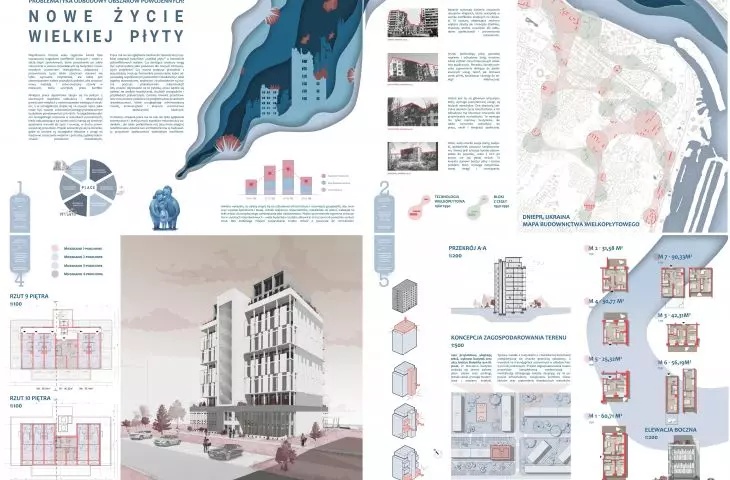Reconstruction of damaged post-war areas is one of the greatest challenges for contemporary architecture and urban planning. Armed conflicts destroy not only the infrastructure, but also the social fabric, which requires a comprehensive and sustainable approach to reconstruction. Ana K. from the Sopot Academy of Applied Sciences takes up this topic, focusing on the problem of modernization of large-panel buildings, taking into account the needs of modern society. The project, created under the supervision of Dr. Bartosz Felski, focuses on the reconstruction of Ukrainian cities, but its flexibility allows it to be applied to other parts of Europe.
board
© Ana K.
project goals and objectives
The student proposal aims to modernize large slab buildings, often symbols of past destruction and neglect. The author aims to create a flexible design that can be adapted to different geographical and financial contexts. A key idea is to use closed-loop architecture and recycled materials to minimize environmental impact and reduce reconstruction costs. The young architect also envisions creating community spaces that foster the integration of male and female residents and improve the quality of life in rebuilt neighborhoods.
existing structure
© Ana K.
ecological approach to reconstruction
One of the most important aspects of the project is the use of ecological solutions. Ana K. proposes to use recycled materials, such as concrete rubble and melted reinforced concrete, to reduce the use of new raw materials and reduce greenhouse gas emissions. It introduces modern thermal insulation systems, improving the energy efficiency of the buildings and reducing operating costs and contributing to environmental protection.
projections
© Ana K.
modernization of building facades
The project focused on changing the facade of the large slab buildings, improving their aesthetics and bringing them up to modern standards. The modernization included replacing gray facades with new, colorful designs. Innovative materials and technologies, such as terraces and glazed surfaces, increase the visual appeal of the buildings, as well as improve their functionality.
projections
© Ana K.
community spaces
An important element of the project is the introduction of community spaces at the ground level of the buildings. Such a solution promotes the integration of male and female residents and fosters a sense of security in the community. The functionality of the buildings has been optimized: the first two floors serve a social-service function, while the upper floors are intended for apartments with different layouts, adapted to the needs of different social groups, including the elderly, people with disabilities and large families.
site development concept and sections
© Ana K.
modularity and scalability of the project
The design premise includes the use of modular solutions, allowing buildings to be flexibly adapted to different needs. The modular approach allows for the rapid construction of new buildings or the superstructure of existing structures, which is particularly important in the reconstruction process after armed conflict. This allows efficient management of resources and adaptation of architectural solutions to current financial and technological conditions.
detail
© Ana K.
Although the project introduces architectural changes, architecture here serves primarily as a tool for solving social problems. Changes in the spatial layout, aesthetics and functionality of buildings are means to achieve broader goals, such as improving the quality of life, strengthening social ties and creating a more welcoming and sustainable living space.

































